Reverse-engineering Rosetta 2 part2: Analyzing other aspects of Rosetta 2 runtime and AOT shared cache files¶
date: 2021/3/4 (updated 2021/5/16: fix some mistakes & typos)
author: Koh M. Nakagawa
Introduction¶
In part2, I will discuss three features of the Rosetta 2 runtime:
- communicating with
oahd - loading and parsing AOT files to be mapped
- logging in debug mode
I will then introduce an AOT shared cache file, which plays a similar role to the dyld_shared_cache.
Features of Rosetta 2 runtime¶
In the "Roles of oahd and oahd-helper" section of part1, I explained that oahd checks for AOT files and runs oahd-helper to create AOT files if needed.
However, the logs of EventMonitor do not contain detailed information on how oahd obtains x86_64 executables to be translated.
Moreover, we could not figure out how emulation process gets the AOT files required for the execution.
Such information was missing because we could not get some parts of the inter-process communication (IPC) through the Endpoint Security Framework.
In this section, I will discuss the inter-process communication between oahd and runtime to answer these questions.
Then, I will introduce runtime's features of loading and parsing AOT files.
During analyzing the parsing logic of AOT files in runtime, I found a new Mach-O command called LC_AOT_METADATA.
So, I will mainly focus on the LC_AOT_MEATADATA command and its structure.
Feature of Rosetta 2 runtime: communicating with oahd¶
oahd passes x86_64 executables and AOT files through inter-process communication with the Rosetta 2 runtime.
This is achieved by passing these file descriptors through Mach IPC via the following two undocumented system calls.
sys_fileport_makeportsys_fileport_makefd
If you are not familiar with these system calls, you can find a brief description of these system calls here.
First, the Rosetta 2 runtime calls sys_fileport_makeport to create a new Mach port (Figure 1).
The file descriptor of an x86_64 executable is passed as the first argument.

runtime calling sys_fileport_makeport to make a new Mach port.Through the created Mach port, oahd receives the file descriptor of the x86_64 executable (Figure 2).
It then calculates the SHA-256 hash from the file path and the file contents (Figure 3) and uses that hash to search for an existing AOT file.
If not found, oahd executes oahd-helper to create a new AOT file.
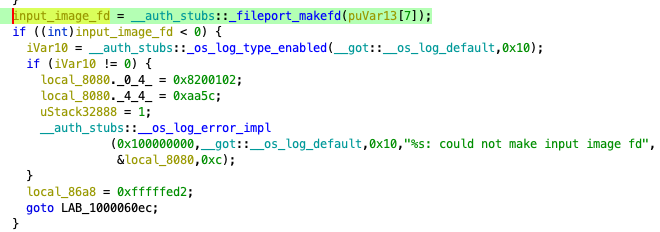
oahd calling sys_fileport_makefd.
oahd calculating the SHA-256 hash.The file descriptor of the AOT file (created or found by the search) is sent back to the Rosetta 2 runtime via Mach IPC.
The Rosetta 2 runtime calls sys_fileport_makefd to receive the file descriptor of the AOT file (Figure 4).

runtime calling sys_fileport_makefd.The Rosetta 2 runtime parses the received AOT file (FUN_00008424 in Figure 5) and maps it onto memory for each segment (mmap_aot_file in Figure 5).
In the FUN_00008424 function, FUN_00008814 (named load_macho) is called to load Mach-O files.
We will see the details of load_macho in the next section.
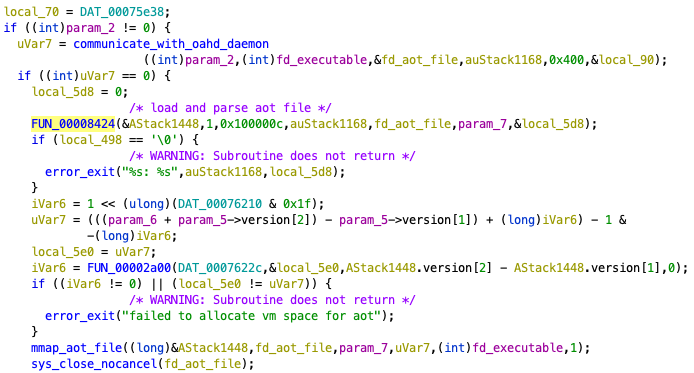
runtime parsing and memory-mapping AOT files.Figure 6 summarizes the overview of this execution flow.
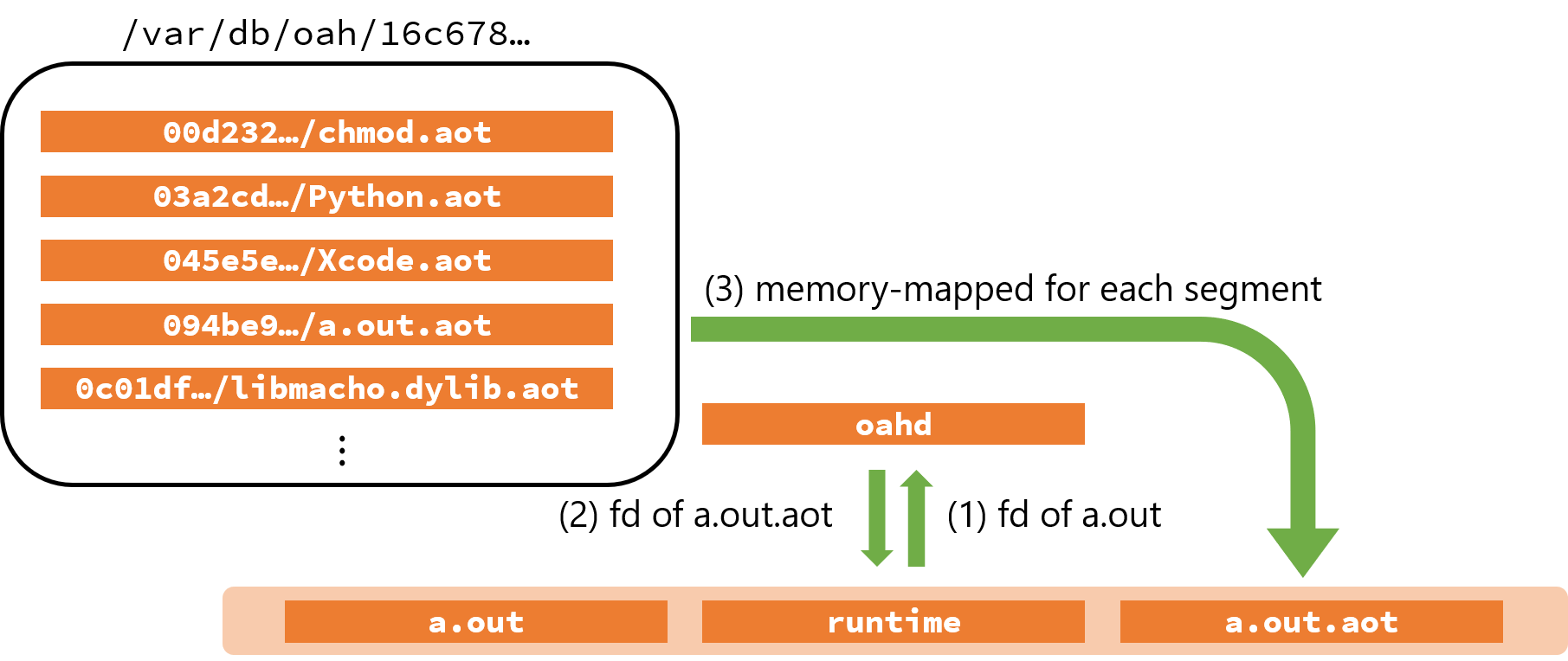
runtime and oahd.Before going to the next, let's discuss the difference between Rosetta 2 and Windows 10 on Arm x86 emulation.
In Windows 10 on Arm, the module filehandle to be translated is passed from xtajit.dll to XtaCache.exe via ALPC (for more details, see Cylance Research team blog post).
Although the way to pass x86 (or x86_64) executables is almost the same as Rosetta 2, translated files are created at different times in Windows 10 on Arm and Rosetta 2.
In Rosetta 2, AOT files are created by oahd-helper before the actual start of an x86_64 executable.
The created AOT files are then used when running the x86_64 executable firstly.
Therefore, in the case of Rosetta 2, if the size of the x86_64 code to be translated is large, it will take some time to start the program for the first time.
On the other hand, in the case of Windows 10 on Arm, XTA cache files are created after (or while) an x86 executable runs. The XTA cache files are not used at the application's first launch. Therefore, although the startup itself is fast, the subsequent process tends to be slower because the x86 code is JIT-translated during the execution.
Feature of Rosetta 2 runtime: parsing AOT files (a new command LC_AOT_METADATA)¶
As mentioned in part1, an AOT file itself is just a Mach-O file. So, AOT files pass the runtime information, such as addresses to be mapped and the entry points, to the loader through load commands.
In the Rosetta 2 runtime, the load_macho function parses these load commands.
Notably, it parses a command called LC_AOT_METADATA, which is specific to AOT files (Figure 7).
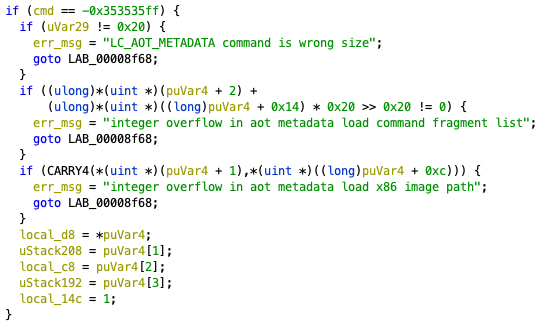
load_macho parsing LC_AOT_METADATA.LC_AOT_METADATA is a load command with the 0xcacaca01 command number.
The contents of the record cannot be displayed by otool.
It is currently an undocumented load command.
$ otool -l hello.out.aot
(...snip...)
Load command 4
cmd ?(0xcacaca01) Unknown load command
cmdsize 32
000000b8 00000021 000000e0 00000001 00003f60 00000000
(...snip...)
The following is the reverse-engineering result of LC_AOT_METADATA command structure.
It contains the information about the code section and the offset to the path name of the x86_64 executable.
struct lc_aot_metadata {
uint32_t cmd; // 0xcacaca01
uint32_t cmdsize; // Always 32
uint32_t offset_to_image_path; // Offset to image path name of x86_64 executable from AOT file's __LINKEDIT segment
uint32_t image_path_length; // Length of image path name
uint32_t field_0x10; // unknown
uint32_t field_0x14; // unknown (always 1, otherwise an x86_64 application will crash)
uint32_t x86_64_code_section; // RVA of x86_64 code section
uint32_t field_0x1c; // unknown
};
We can set the x86_64_code_section to an invalid value and still run the application without any problem.
As for image_path_length and offset_to_image_path, if an integer overflow does not occur, they can be set to invalid values.
These two records are probably used for debugging purposes.
Rosetta 2 runtime's debugging features¶
The Rosetta 2 runtime retains some features that were probably used internally by Apple for debugging purposes.
This can be enabled by passing strings starting with the prefix ROSETTA_ as an environment variable*.
If these strings are passed, the global variables that control debugging features will be set to 1.
* The value is obtained from a structure holding the environment variables on the stack. The initialization of this structure seems to be performed by the kernel.
Figure 8 shows the function in Rosetta 2 runtime enabling the debugging features.
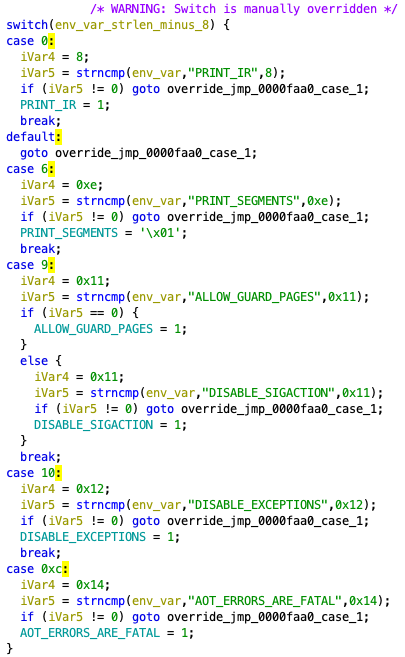
runtime enabling the debugging features.I confirmed the following debugging features in the Rosetta 2 runtime.
ROSETTA_PRINT_IRROSETTA_PRINT_SEGMENTSROSETTA_ALLOW_GUARD_PAGESROSETTA_DISABLE_EXCEPTIONSROSETTA_AOT_ERRORS_ARE_FATAL
In this article, I will discuss the ROSETTA_PRINT_IR and ROSETTA_PRINT_SEGMENTS.
ROSETTA_PRINT_IR¶
ROSETTA_PRINT_IR is a debugging feature to show the x86_64 code being translated to the standard error output.
If the flag is enabled, the show_log (defined at runtime+0x57694) function will be called in the translate function described in part1 to display the x86_64 code being translated (Figure 9).

translate in runtime calling show_log to show the translated x86_64 code.Let me show you an example output by show_log.
Let's take the program executing the shellcode in part1, and check the output when the ROSETTA_PRINT_IR function is enabled.
Start LLDB, write 1 to the ROSETTA_PRINT_IR flag, and execute the program.
(lldb) process launch --stdout out.log --stderr print_ir.log
* thread #2, stop reason = exec
frame #0: 0x00007ffdfff7a46c runtime`_mh_execute_header + 9324
runtime`_mh_execute_header:
-> 0x7ffdfff7a46c <+9324>: mov x19, sp
0x7ffdfff7a470 <+9328>: and sp, x19, #0xfffffffffffffff0
0x7ffdfff7a474 <+9332>: mov x29, sp
0x7ffdfff7a478 <+9336>: ldr x20, [x19, #0x20]
Target 0: (runtime) stopped.
(lldb) memory write 0x7ffdfffeda4e 1
(lldb) c
After the execution, I got a standard error output. Here is the snippet of this log.
20002a939 BB_1
preds BB_0
20002a939 mov eax, [r13 + 0x4]
20002a93d add r13, rax
20002a940 inc ebx
20002a942 cmp ebx, esi, def #nzcvpa
20002a944 jcc ne, 0x20002a678, fallthrough BB_2
20002a94a BB_2
preds BB_1
20002a94a jmp BB_3
20002a96d BB_3
flags liveout #nzcvpa, livein <none>
preds BB_2
20002a96d cmp [rbp - 0x40], 0x0, def #nzcvpa
20002a972 jcc ne, BB_13, fallthrough BB_4
(...snip...)
You can see that the leftmost column shows the address where the instruction exists, and the next column shows the corresponding x86_64 assembly.
In addition, for each basic block, metadata such as preds and flags are listed.
The preds points to the basic block from which the jump is made.
The details about flags liveout #nzcvpa and livein <none> is currently unknown, but it probably indicates the flag register changes when these instructions are executed.
Next, look at the disassembly result around 0x1082f4000.
(...snip...)
(JIT translated x86_64 code)
1082f4000 BB_0
preds
1082f4000 xor rax, rax
1082f4003 cdq
1082f4004 push rax
1082f4005 mov rdi, 0x68732f6e69622f2f
1082f400f push rdi
1082f4010 push rsp
1082f4011 pop rdi
1082f4012 xor rsi, rsi
1082f4015 mov al, 0x2
1082f4017 ror rax, 0x28
1082f401b mov al, 0x3b
1082f401d syscall fallthrough BB_1
You can see that this is the JIT-executed x86_64 code in the sample in part1.
The ROSETTA_PRINT_IR debugging feature can likely be used to trace the translated x86_64 code.
ROSETTA_PRINT_SEGMENTS¶
ROSETTA_PRINT_SEGMENTS is a debugging feature that displays the map status of AOT files, Rosetta 2 runtime, and executable segments to the memory.
As in the previous section, after running the program via LLDB, we can get the following logs by enabling ROSETTA_PRINT_SEGMENTS.
- A standard error when
ROSETTA_PRINT_SEGMENTSis enabled - A standard output when
ROSETTA_PRINT_SEGMENTSis enabled
Firstly, let's look at the standard error.
runtime mapped at 0x7ffdfff78000
segments for /var/db/oah/16c6785d8fdab5ee2435f23dc2962ceda2e76042ea2ad1517687c5bb7358bf00/b3690b640c30cc1cd5d018dfefc14f1069ab08653c96f0d1c1028c0088a7832e/run_shellcode.out.aot:
mapping __TEXT at [0x100010000, 0x1000111e8)
mapping RuntimeRoutines at [0x100012000, 0x100016000)
mapping __LINKEDIT at [0x100017000, 0x100017168)
You can see that it shows the address that the Rosetta 2 runtime is mapped to, and where the segments of the AOT files are mapped to.
Comparing this with the vmmap command result, we can see that it does indeed match.
mapped file 100010000-100012000 [ 8K 8K 0K 0K] r-x/rwx SM=COW /private/var/db/*/run_shellcode.out.aot
mapped file 100012000-100016000 [ 16K 16K 0K 0K] r-x/r-x SM=COW /Library/Apple/*/runtime
mapped file 100017000-100018000 [ 4K 4K 0K 0K] r--/rwx SM=COW /private/var/db/*/run_shellcode.out.aot
Next, let's take a look at the standard output.
Re-using existing aot shared cache:
[0x0, 0x106e0000) init_prot=1 max_prot=1
[0x106e0000, 0x11138000) init_prot=3 max_prot=3
[0x11138000, 0x9ae54000) init_prot=85 max_prot=85
[0x7ffe963e4000, 0x7ffe963e75ac] RuntimeRoutines
[0x7ffe963e75ac, 0x7ffe963e8594] /usr/lib/system/libsystem_blocks.dylib
[0x7ffe963e8594, 0x7ffe964382a4] /usr/lib/system/libxpc.dylib
[0x7ffe964382a4, 0x7ffe9645b00c] /usr/lib/system/libsystem_trace.dylib
[0x7ffe9645b00c, 0x7ffe965031bc] /usr/lib/system/libcorecrypto.dylib
[0x7ffe965031bc, 0x7ffe9653da4c] /usr/lib/system/libsystem_malloc.dylib
(...snip...)
(...snip...)
It likely shows a list of addresses where each dylib is mapped.
Again, let's compare it with the result of vmmap.
(...snip...)
mapped file 7ffe852ac000-7ffe9598c000 [262.9M 32.8M 0K 0K] r--/r-- SM=COW Object_id=8f689f0f
mapped file 7ffe963e4000-7fff20100000 [ 2.2G 59.4M 0K 0K] r-x/r-x SM=COW Object_id=8f689f0f
__TEXT 7fff20146000-7fff20148000 [ 8K 8K 0K 0K] r-x/r-x SM=COW /usr/lib/system/libsystem_blocks.dylib
__TEXT 7fff20148000-7fff2017e000 [ 216K 152K 0K 0K] r-x/r-x SM=COW /usr/lib/system/libxpc.dylib
__TEXT 7fff2017e000-7fff20196000 [ 96K 80K 0K 0K] r-x/r-x SM=COW /usr/lib/system/libsystem_trace.dylib
__TEXT 7fff20196000-7fff20235000 [ 636K 124K 0K 0K] r-x/r-x SM=COW /usr/lib/system/libcorecrypto.dylib
__TEXT 7fff20235000-7fff20262000 [ 180K 132K 0K 0K] r-x/r-x SM=COW /usr/lib/system/libsystem_malloc.dylib
(...snip...)
Oddly enough, there seems to be a discrepancy with the result of ROSETTA_PRINT_SEGMENTS.
According to the vmmap result, libsystem_blocks.dylib is mapped to [0x7fff20146000, 0x7fff20148000].
However, the results of ROSETTA_PRINT_SEGMENTS output says it is mapped to [0x7ffe963e75ac, 0x7ffe963e8594].
Also, when you look at the addresses mapped by ROSETTA_PRINT_SEGMENTS in the vmmap command result, you can figure out that a single huge file of 2.2GB is mapped.
(...snip...)
mapped file 7ffe963e4000-7fff20100000 [ 2.2G 59.4M 0K 0K] r-x/r-x SM=COW Object_id=8f689f0f
(...snip...)
What is this file?
This is an AOT shared cache file, which is displayed at the top of the log. Next, let's take a deeper look at the contents of the AOT shared cache file.
AOT shared cache file¶
Quick look at AOT shared cache file¶
You may think of dyld_shared_cache when you hear "shared cache."
In fact, you can find a new file corresponding to the AOT shared cache in the folder where dyld_shared_cache is.
$ ls -lh /System/Library/dyld/
total 7733712
-rwxr-xr-x 1 root admin 2.4G 1 1 2020 aot_shared_cache
-rwxr-xr-x 1 root admin 0B 1 1 2020 aot_shared_cache.t8027
-rwxr-xr-x 1 root admin 2.1G 1 1 2020 dyld_shared_cache_arm64e
-rwxr-xr-x 1 root admin 729K 1 1 2020 dyld_shared_cache_arm64e.map
-rwxr-xr-x 1 root admin 2.3G 1 1 2020 dyld_shared_cache_x86_64
-rwxr-xr-x 1 root admin 562K 1 1 2020 dyld_shared_cache_x86_64.map
-rwxr-xr-x 1 root admin 2.3G 1 1 2020 dyld_shared_cache_x86_64h
-rwxr-xr-x 1 root admin 562K 1 1 2020 dyld_shared_cache_x86_64h.map
You can also see that the file size is about 2.4GB, which is roughly the same size as the file mentioned at the end of the previous section. This file seems to be mapped into the memory.
Now, let's check the file type of aot_shared_cache with the file command.
$ file /System/Library/dyld/aot_shared_cache
/System/Library/dyld/aot_shared_cache: data
Oops, the file command says data.
Let's also look at the results from Patrick Wardle's excellent tool WYS.
In general, WYS is better than the file command at estimating file types.
Unfortunately, however, it also displays data as the file type (Figure 10).
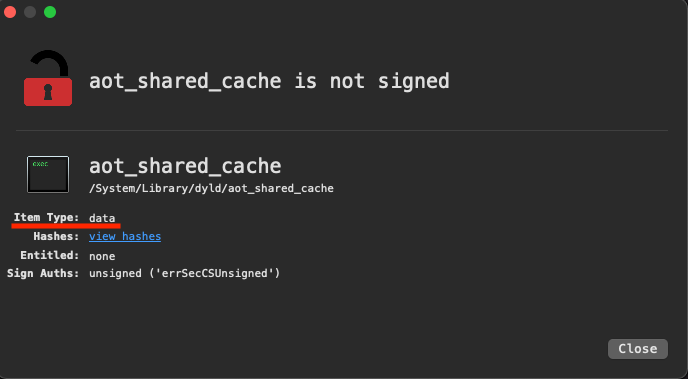
It seems to be a file type that is not yet publicly known.
I did some search on the web about AOT shared cache files. However, it seems that the file format has not been analyzed yet.
Analyzing AOT shared cache files¶
Since there was no analysis of the file format, I decided to analyze it on my own.
After digging Rosetta 2 runtime, I found that the function 0x13cbc+runtime in the Rosetta 2 runtime is loading the AOT shared cache file.
I named this function load_aot_shared_cache.
As far as I know, load_aot_shared_cache does the following.
- It gets the base address of the region where the AOT shared cache file is mapped by using the
shared_region_check_npsystem call.- Like the
dyld_shared_cache, the purpose of loading the AOT shared cache file is to improve the performance of the process initialization.
- Like the
- It checks the magic number and the version information in the AOT shared cache file.
- If
ROSETTA_PRINT_SEGMENTSis enabled, it shows the segment information of the AOT shared cache file to standard output. - It calls the function
0x13908+runtime(namedparse_aot_shared_cache) to parse the AOT shared cache file and store some fields as global variables.
The file structure of the AOT shared cache file is determined by reverse-engineering the parse_aot_shared_cache.
The file structure is shown below (Figure 11).
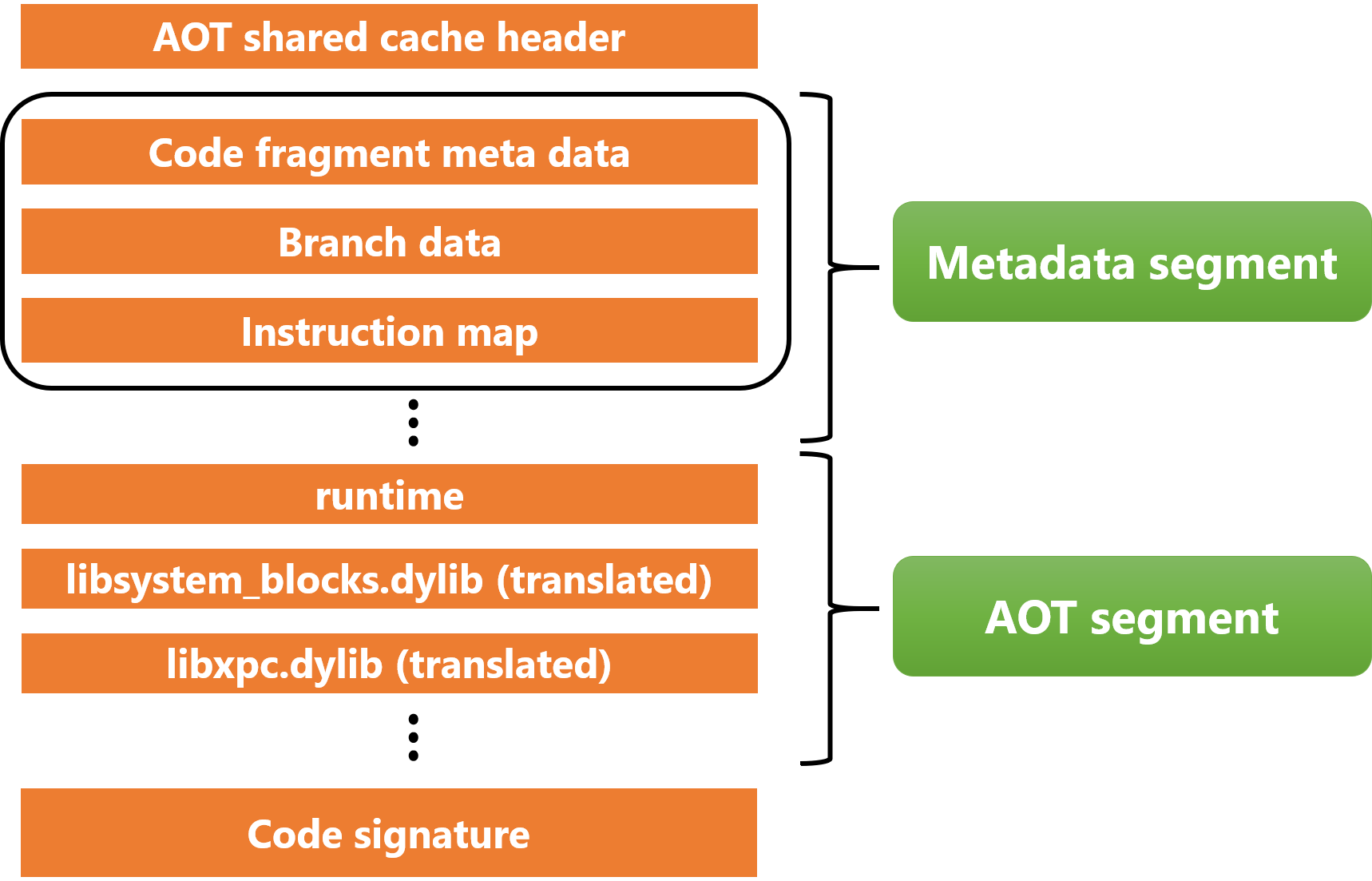
First, the header contains information such as the offset to the subsequent segments, the offset size to the code signature, and so on. Each member of the header of the AOT shared cache looks like this.
// It seems to be the same structure as _shared_region_mapping_np
// See https://opensource.apple.com/source/dyld/dyld-95.3/src/ImageLoaderMachO.cpp.auto.html
struct AotCacheMappingInfo {
uint64_t address;
uint64_t size;
uint64_t file_offset;
uint32_t init_prot;
uint32_t max_prot;
};
struct AotCacheHeader {
uint64_t magic; // Always 0x6568636143746F41 ("AotCache" in ASCII)
uint64_t field_0x8; // Unknown
uint64_t field_0x10; // Unknown
uint64_t uuid[2]; // UUID
uint64_t version[4]; // Version of AOT shared cache
uint64_t offset_to_codesig; // Offset to code signature of AOT shared cache
uint64_t size_of_codesig; // Size of code signature of AOT shared cache
uint32_t n_entries; // Number of entries of meta data
uint32_t offset_to_metadata_seg; // Offset to metadata segment
struct AotCacheMappingInfo mapping[3]; // Information of each segment
};
After the AOT shared cache header, there is a metadata segment. It contains three sets of data: code fragment metadata, branch data, and instruction map, as many as the number of images in the AOT shared cache.
The code fragment metadata has the following structure.
struct CodeFragmentMetadata {
uint32_t type; // 1 (Rosetta 2 runtime) 0 (AOT file without file header)
uint32_t offset_to_path_name; // Offset to path name from the text segment
uint32_t offset_to_x64_code; // Offset to x64 code from the text segment
uint32_t size_of_x64_code; // Size of x64 code
uint32_t offset_to_arm64_code; // Offset to arm64 code from the aot segment
uint32_t size_of_arm64_code; // Size of arm64 code
uint32_t offset_to_branch_data; // Offset to branch data from the meta data segment
uint32_t size_of_branch_data; // Size of branch data
uint32_t offset_to_insn_map; // Offset to instruction map from the meta data segment
uint32_t size_of_insn_map; // Size of instruction map from the meta data segment
};
The branch data and the instruction map structures are unknown. We can guess that the structure holds the correspondence between the arm64 code and x86_64 code addresses in the AOT shared cache from these names.
The AOT segment follows the metadata segment, which contains the data from the Rosetta 2 runtime and the dylib AOT files for various systems.
After the AOT segment, you can see that there is a code signature. This is used to verify the integrity of the AOT shared cache before it is loaded into the memory.
Next, let's look at how the AOT shared cache is mapped onto the memory (Figure 12).
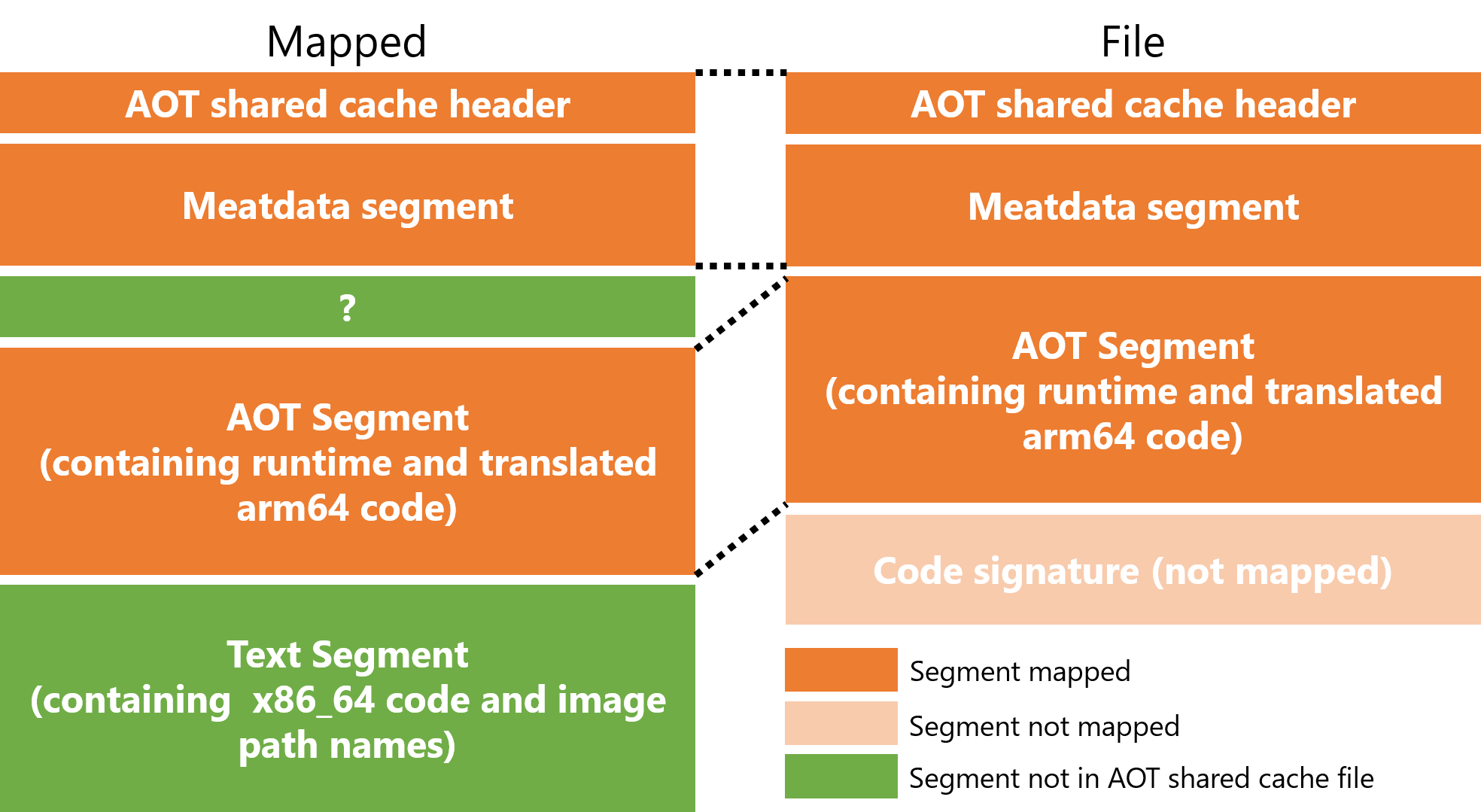
When it is mapped onto the memory, two new segments are added (green rectangles in Figure 12).
The text segment followed by the AOT segment contains the path information of the image in the AOT shared cache and the x86_64 code.
The two members of CodeFragmentMetadata, offset_to_path_name, and offset_to_x64_code, are the offsets from the starting address of this segment.
The text segment information is not contained in the AOT shared cache file, and it is not clear which file contains it. I suspect that this information is extracted from dyld_shared_cache and written to the memory.
AotSharedCacheExtractor¶
Based on the reverse-engineering results, I created a Python script parsing AOT shared cache files and dumps the information in them.
Currently, two commands have been implemented to dump the header information of the AOT shared cache files and extract the code signature of them.
$ python main.py dump /path/to/aot_shared_cache
AotCacheHeader:
magic: 0x6568636143746f41
field_0x8: 0x901e87ff163d262d
field_0x10: 0xd530e2b9dd65e280
uuid: ['0xac30dd6830a6b1e2', '0xda54b118c06a36a0']
version: ['0xeeb5da8f5d78c616', '0xed2c96c23df23524', '0x51d12aea4260e7a2', '0xbf5873bbc58776']
offset_to_codesig: 0x9a3fc000
size_of_codesig: 0x134800b
n_entries: 0x784
offset_to_metadata_seg: 0x4000
mapping:
AotCacheMappingInfo:
address: 0x0
size: 0x106e0000
file_offset: 0x0
init_prot: 0x1
max_prot: 0x1
AotCacheMappingInfo:
address: 0x106e0000
size: 0xa58000
file_offset: 0x0
init_prot: 0x3
max_prot: 0x3
AotCacheMappingInfo:
address: 0x11138000
size: 0x89d1c000
file_offset: 0x106e0000
init_prot: 0x85
max_prot: 0x85
metadata segment starts from 0x4000
number of entries is 1924
CodeFragmentMetaData:
type: 0x1
offset_to_path_name: 0x0
offset_to_x64_code: 0x0
size_of_x64_code: 0x0
offset_to_arm64_code: 0x0
size_of_arm64_code: 0x35ac
offset_to_branch_data: 0x0
size_of_branch_data: 0x0
offset_to_insn_map: 0x0
size_of_insn_map: 0x0
[0x106e0000, 0x106e35ac] RuntimeRoutines
CodeFragmentMetaData:
type: 0x0
offset_to_path_name: 0x46880
offset_to_x64_code: 0x47279
size_of_x64_code: 0x5df
offset_to_arm64_code: 0x35ac
size_of_arm64_code: 0xfe8
offset_to_branch_data: 0x50
size_of_branch_data: 0x7c
offset_to_insn_map: 0xcc
size_of_insn_map: 0x190
[0x106e35ac, 0x106e4594] /usr/lib/system/libsystem_blocks.dylib
branch data: [0x4050, 0x40cc]
instruction map: [0x40cc, 0x425c]
...
$ python extract-codesig /path/to/aot_shared_cache codesig
Will extract a code signature located at [0x9a3fc000, 0x9b74400b]
The extracted code signature is saved to code_sig
$ file code_sig
code_sig: Mac OS X Detached Code Signature (non-executable) - 20217867 bytes
This can be used to find out which address in AOT shared cache files contain what image, or to dump the header information.
Note that I have only tested this with aot_shared_cache in macOS Bug Sur version 11.1.
Please be aware of this when using this script on your environment.
Conclusion¶
In part2, I have explained the following three features of the Rosetta 2 runtime.
- Inter-process communication with
oahd, through which file descriptors for x86_64 executables and AOT files are passed. - Parsing
LC_AOT_MEATADATAcommand specific to Mach-O in AOT files - Logging in debug mode
- Showing translated x86_64 code by
ROSETTA_PRINT_IR - Showing the address of the mapped AOT files and the address range of each image in the AOT shared cache file by
ROSETTA_PRINT_SEGMENTS.
- Showing translated x86_64 code by
I also introduced the AOT shared cache file and its file structure.
Recently, Arm processors have been adopted for laptop and server applications, not limited to embedded applications. In this processor transition, two different emulation technologies have been introduced by Microsoft and Apple. In the past, Apple has introduced Rosetta, but this is the first time that several different OS vendors have introduced similar emulation technology at the same time.
As briefly discussed in this article ("Feature of Rosetta 2 runtime: communicating with oahd"), there are some differences between the two technologies.
Examining the differences between the two technologies can provide useful insights for future developers of similar emulation technologies.
I hope that this article will lead to further analysis of Rosetta 2 and research on how it differs from the Windows 10 on Arm x86 emulation.